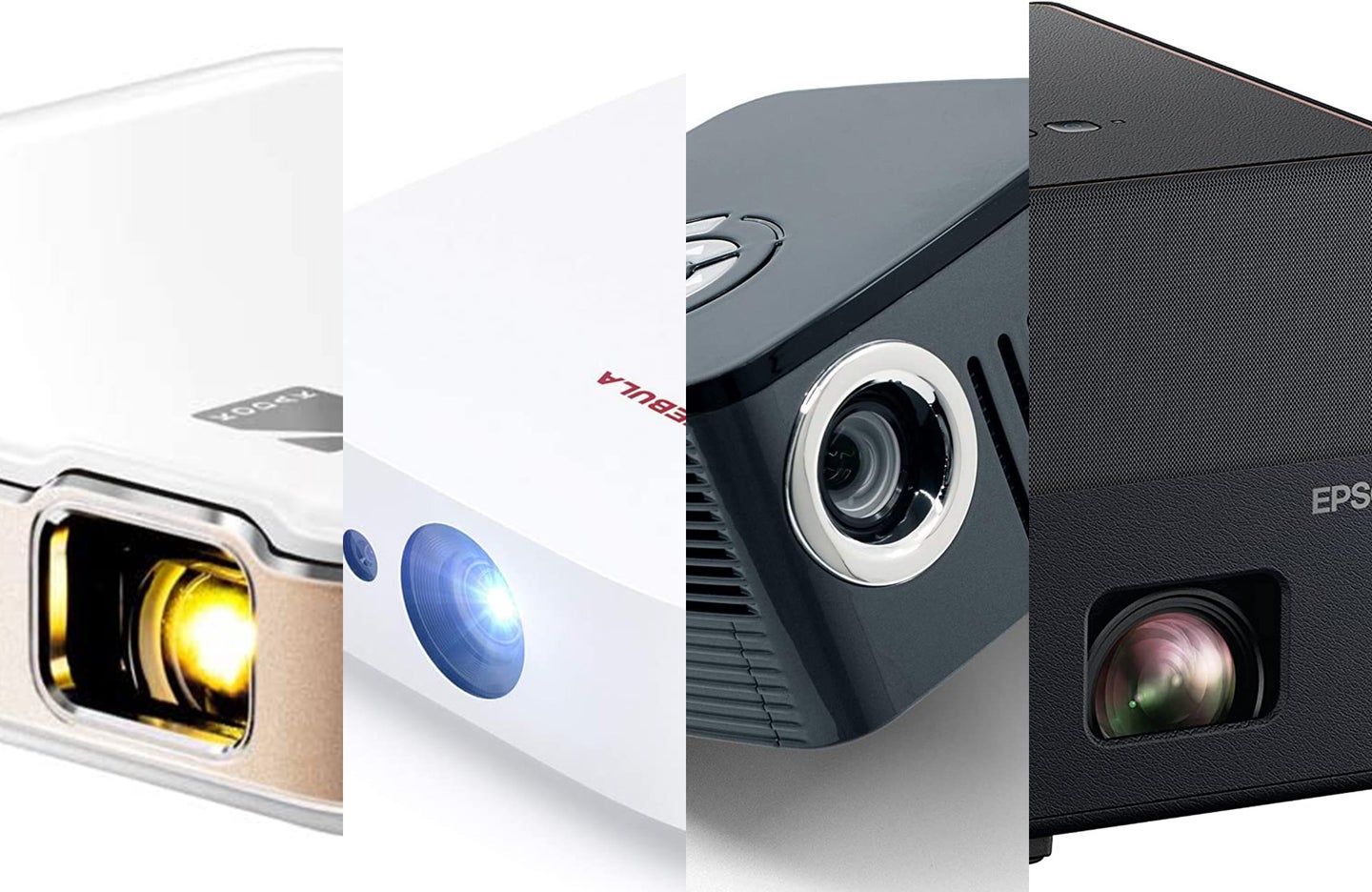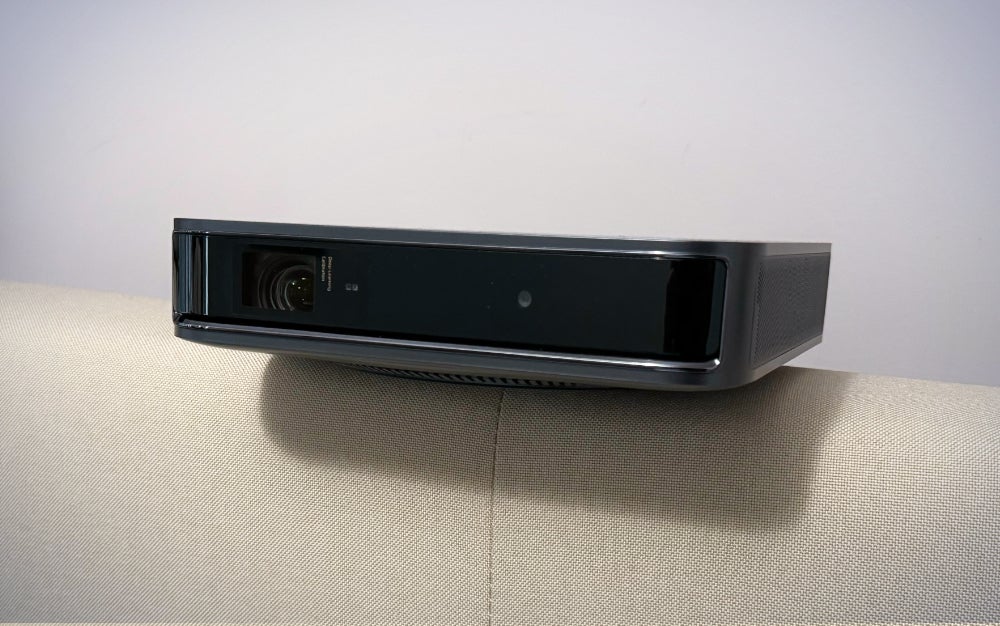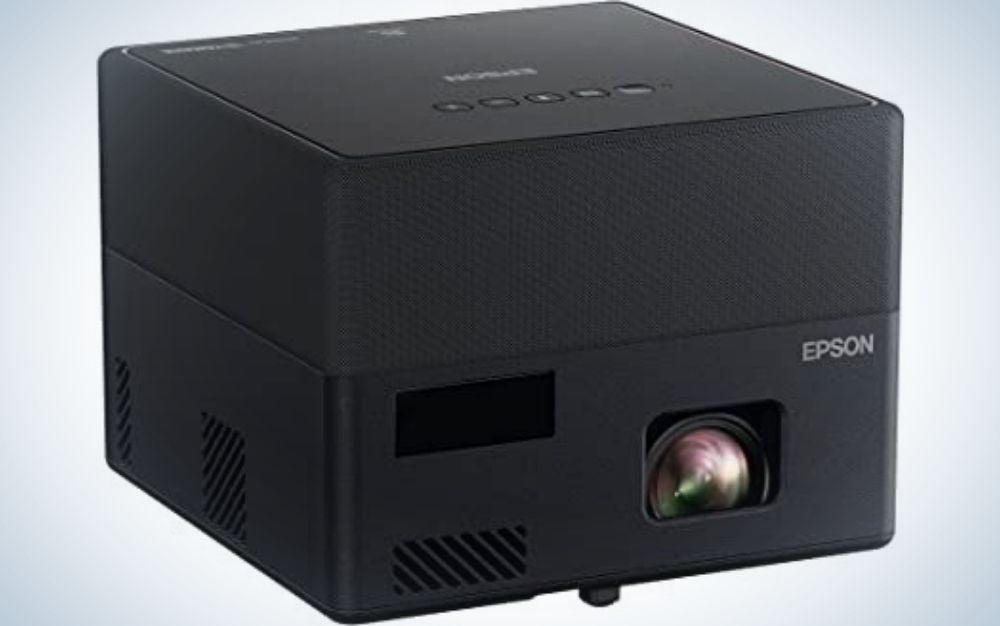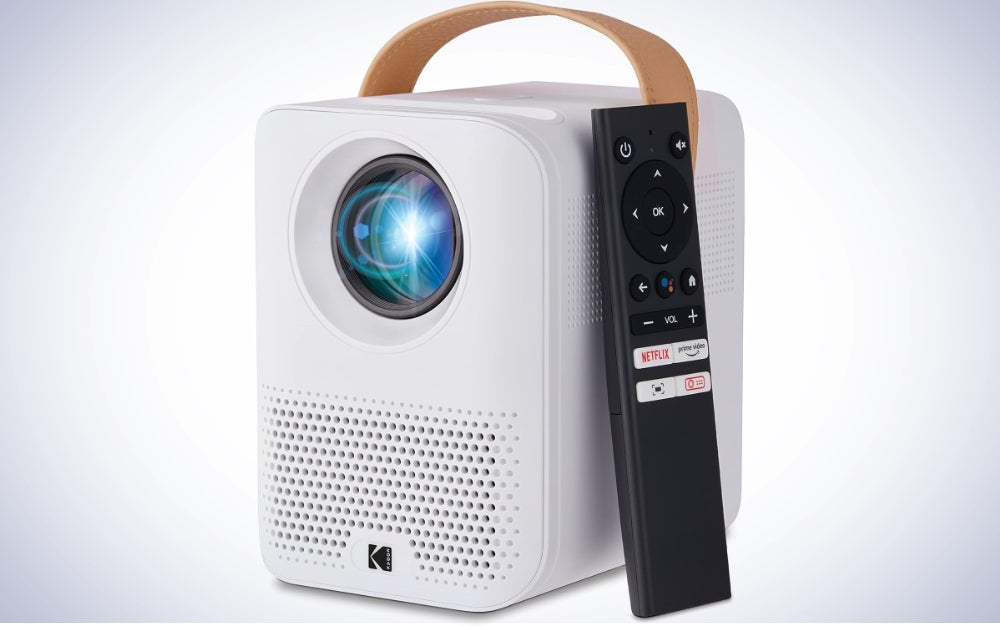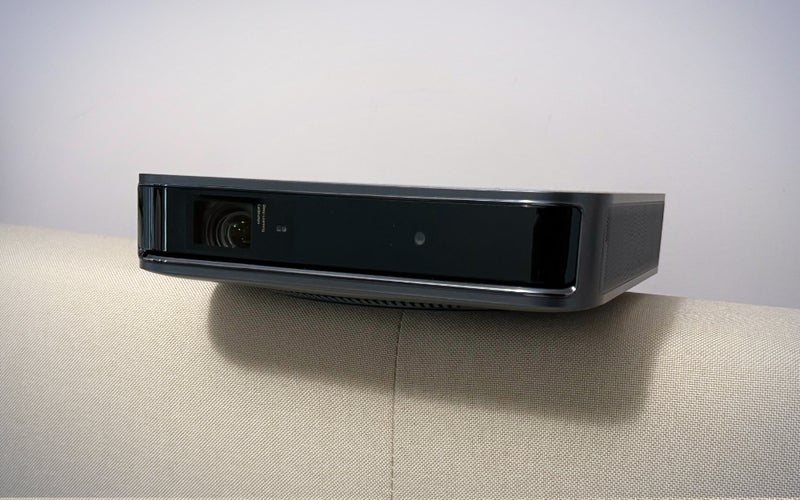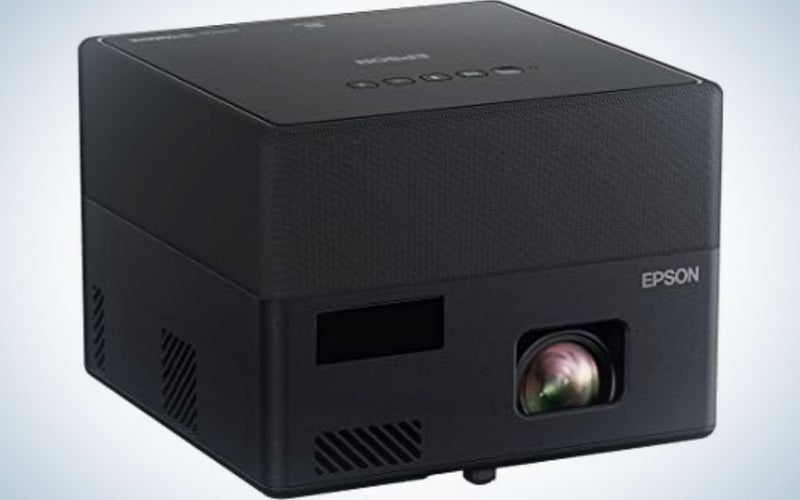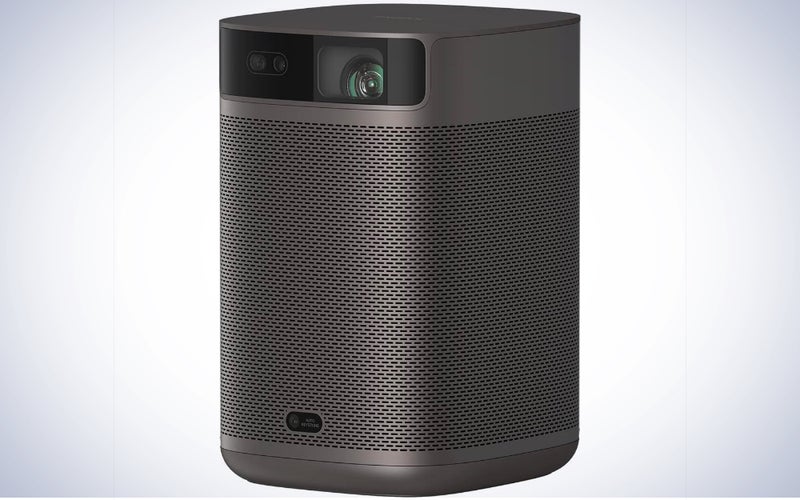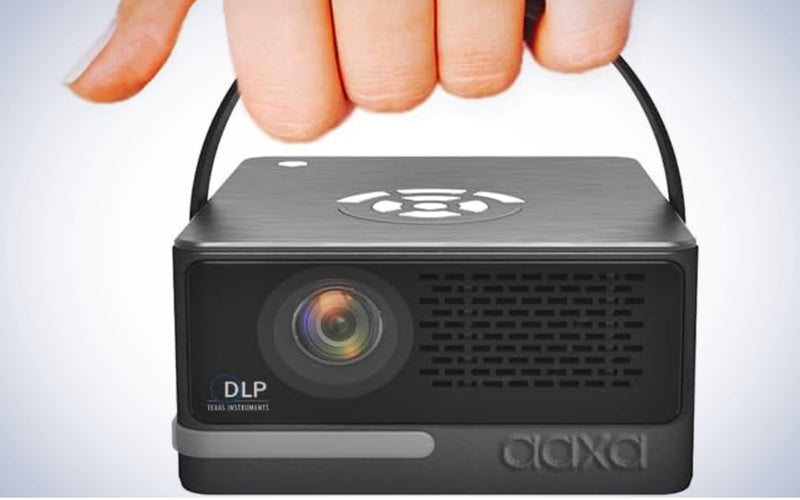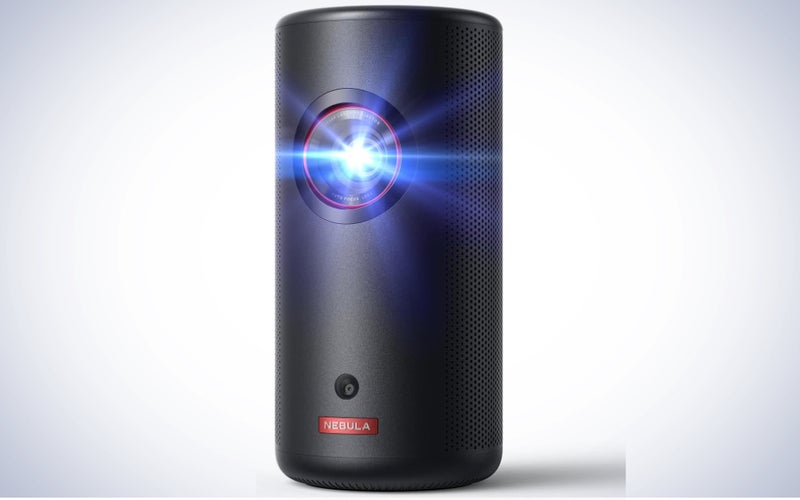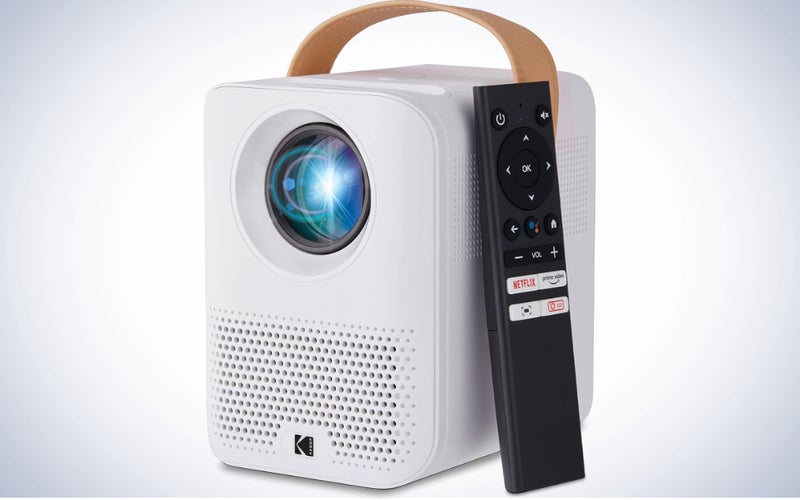We may earn revenue from the products available on this page and participate in affiliate programs. Learn more ›
Mini projectors balance size, features, price, and image quality. Is it easy to pack big entertainment in a small package? Nope, so when purchasing a mini projector, managing your expectations is important. These units will never match the brightness, resolution, color saturation, contrast, or picture size you get from a full-size projector. On the other hand, try slipping one of those 20-pound monsters into your carry-on bag or using it in a small office or a dorm room. Ideally, the best mini projectors weigh a few pounds or less—sometimes much less—but are bright enough for presentations and to display photos, spec sheets, or whatever else you’d like.
These small entertainment units often include built-in batteries for truly portable play, and some have Android TV functionality for easy streaming. Integrated speakers are common, and there are often HDMI and USB ports for external media like Blu-ray players, set-top streaming boxes, or USB streaming sticks. Finding the best mini projector that meets your priorities isn’t always easy, so we’ve gathered six of the best mini projectors while also providing some insight into what to look for when you’re shopping.
- Best overall: Dangbei Atom
- Best for movies: Epson EpiqVision Mini EF12
- Best for gaming: XGIMI MoGo 2 Pro
- best pocket-sized: AAXA P6 Ultimate
- Best for travel: NEBULA Capsule 3
- Best budget: Kodak FLIK HD9
How we chose the best mini projectors
When selecting the best mini projectors to include in our recommendations, we relied on our experience with home projectors, and we reached out to professionals in the TV and AV worlds to discuss their favorites—as well as the types of specs they care about when shopping. We read trade journals and websites and sifted through online reviews and comments to get the impressions of typical users. We narrowed our selection of projectors down to 10, focusing first and foremost on how the unit balanced image quality against its small, portable size. Color, contrast, and resolution were considered, as were size and weight. Price was an important factor, especially in terms of “bang for your buck,” and additional features—like built-in streaming apps, batteries, and speakers—were evaluated as well.
The best mini projectors: Reviews & Recommendations
A little more compact than some portable projectors, while not as limited in features as a pico projector, the best mini projectors are all-in-one entertainment.
Best overall: Dangbei Atom
Brandt Ranj / Popular Science
Why it made the cut: This small, light projector ticks all our boxes with a native 1080p picture, a reasonably bright lamp, a built-in battery, and an onboard speaker.
Specs
- Brightness: 1200 lumens
- Size: 10.03 x 10.03 x 4.92 inches
- Weight: 2.82 pounds
Pros
- Fantastic color reproduction for its size
- Built-in speakers
- Bright for a compact projector
Cons
- Single HDMI port
Leave it to Dangbei to make a mini projector good enough to compare favorably to significantly larger models. It has every essential projector feature, from HDR10 support and solid-sounding built-in speakers to a 1200 lumen bulb, and the ability to project a 180-inch screen. Additional features, like having enough processing power to run Google TV smoothly, Netflix support, the ability to trigger the Google Assistant, and an auto-keystone correction feature that keeps your screen looking tidy, are also available. On a technical level, it’s hard to find any fault with the Dangbei Atom, given its ultra-thin and compact profile and every feature the company managed to cram into this projector.
Our primary tests included playing video games on the Nintendo Switch. In general, colors looked good, games sounded pretty rich, and there wasn’t a discernible amount of latency when playing games like The Legend of Zelda: Breath of the Wild, which admittedly runs at 30 frames per second. The Atom, which clocks in at just 1.87 inches thick and under three pounds, is a technical triumph of engineering given its size. That said, a 1080P image projected on a 100-inch screen does look worse than one at 4K. This wasn’t an issue when playing games on the Nintendo Switch, which tops out at 1080P, but was noticeable when watching videos. If you stream a lot of 4K content, it may be wise to look elsewhere. Our only other complaint is that its single HDMI port means you’ll be swapping out components whenever you want to use a different device.
But the Atom’s size—it was easy to carry the projector and power cable in one hand from room to room—means you can easily take it with you on vacation or set up and break down your big-screen home theater setup in a couple of minutes. The Atom is the ideal mini projector for spaces like dorm rooms or studio apartments.
Best for movies: Epson EpiqVision Mini EF12
Epson
Why it made the cut: Superior contrast, a relatively bright lamp, and advanced imaging technology work to deliver what’s by far the best-looking movies you’ll see from any other projector on this list.
Specs
- Brightness: 1000 ANSI Lumens
- Size: 6.9 x 6.9 x 5 inches
- Weight: 4.7 pounds
Pros
- Native 1080p resolution
- Supports 4K media (down-converted to HD)
- 200,000:1 contrast ratio
- Built-in Android TV
- Excellent speakers
Cons
- A bit heavy by mini standards
- Expensive
The EpiqVision Mini EF12 is more expensive than most other mini projectors, but that’s the trade-off for a positively cinematic movie-watching experience. With a native Full HD 1080p resolution and 1,000-ANSI lumen MicroLaser light source, the unit projects a sharp 140-inch picture. Three-chip LCD technology displays 100 percent of the RGB color range, while high contrast and adaptive color correction deliver shadows full of detail and saturated colors that positively pop.
Built-in Android TV provides access to a full suite of streaming apps, and the EpiqVision Mini has two HDMI inputs for external players. A 5-watt Yamaha speaker delivers robust and clear audio.
Unfortunately, this Android projector doesn’t have an internal battery, so don’t expect to use it without having access to AC power. It’s also a chunkier piece of gear than many mini projectors on this list—this isn’t dropping into anyone’s pocket. And, again, the price—close to $1,000, compared to all our other sub-$500 choices—might make it a tough buy for anyone watching their budget. But if you prioritize your movies above all else, there’s a reason this is one of our favorite home theater projectors.
Best for gaming: XGIMI MoGo 2 Pro
XGIMI
Why it made the cut: The XGIMI MoGo 2 Pro mini projector enhances gaming by providing a crisp picture, a 3D mode, superior audio quality, and low latency.
Specs
- Brightness: 400 ANSI lumens
- Size: 7.76 x 9.57 x 9.69 inches
- Weight: 4.6 lbs.
Pros
- Ultra-portable
- Good image quality for its size
- Great price
Cons
- Dim bulb
If you’d like to game on a mini projector, your best choice is XGIMI’s MoGo 2 Pro. Its only drawback is the brightness of its bulb, which at 400 lumens means you’ll only want to use it in dark rooms. This limitation may be a dealbreaker for you, but if you’re fine with the limitation, you’ll be rewarded in other ways. XGIMI managed to fit a dual-speaker audio system, a processor fast enough to run Android 11 (sans Netflix), object avoidance, and auto keystone correction into a compact package. It lacks HDR, which will matter if you play video games on a PlayStation 5 or Xbox Series X, or pay for the highest tiers of some streaming services, but Nintendo Switch owners and casual streamers won’t be missing out.
A feature called uninterrupted keystone correction will keep your screen—up to 200 inches in size—looking even while you use it. If you’ve been flummoxed by finicky slightly tilted projection screens in the past, this may end up being your favorite features. XGIMI has continually proven it knows how to eke out as much performance as possible from its hardware. This is your answer if you’re a casual gamer who wants to play on the biggest possible screen.
Best pocket-sized: AAXA P6 Ultimate
AAXA
Why it made the cut: With native 720p resolution, this pint-size player delivers a much better picture than you usually get from such a small projector.
Specs
- Lumens: 417 ANSI lumens
- Size: 5.25 x 5.7 x 3.1 inches
- Weight: 4.07 pounds
Pros
- Extremely small size
- 3-hour battery life
- 200-inch maximum screen size
Cons
- One HDMI port
AAXA’s ultimate version of its P6 projector is so small it could actually fit in the pocket of a pair of cargo pants. With a native resolution of 720p, it’s hardly the most powerful projector we’re recommending, but it does support the ability to accept 4K signals. The mini projector’s 417 ANSI bulb is impressive, but be mindful that AAXA lists the projector as having 1,000 LED lumens, which, while accurate, may give the impression that the P6 Ultimate is brighter than it really is. If screen size is your most important metric, the P6 Ultimate holds up well, with the ability to project a 200-inch image. Be mindful that a 200-inch 720p picture will look blurry when compared to higher-resolution projectors.
What makes the P6 Ultimate the best pocket-sized mini projector is its battery, which allows you to run it for up to six hours per charge. You’ll get less watch time if you crank up its brightness to the max, but it’s still impressive that a projector this small has a battery inside. Similarly, AAXA built a speaker into this projector, which is almost unimaginable given its size. The AAXA P6 Ultimate runs AndroidOS natively, so you’ll be able to stream media to it without plugging in a media streamer. That’s great because this mini projector only has a single HDMI port, which is understandable but still a drawback. If you want to get a mini projector that really lives up to that adjective, AAXA’s P6 Ultimate is the one to get.
Best for travel: NEBULA Capsule 3
NEBULA
Why it made the cut: Lightweight and featuring a built-in Android TV, this battery-powered projector travels easily.
Specs
- Brightness: 300 ANSI Lumens
- Size: 3.3 x 3.3 x 6.7 inches
- Weight: 1.98 pounds
Pros
- Up to 2.5 hours of battery life
- Built-in Android TV
- Native HD resolution but can accept 4K inputs
Cons
- Price
If we could only recommend one mini projector for travel, it’d be the latest model in NEBULA’s capsule series. The Capsule 3’s slim, cylindrical shape makes it easy to carry in a backpack. And its battery means you can use it on travels where outlets are fewer and further between. Its technical features, including its native 1080P resolution, eight-watt speaker with Dolby Audio, AndroidOS support, and laser projection system help it stay competitive in this category. NEBULA doubled the Capsule 3’s contrast and improved its color accuracy when compared to the previous generation for those looking to upgrade.
Most importantly, the Capsule 3 is 55% smaller than the model it replaced, and at just under 2 pounds, it’s a lot easier to carry around on trips. Our primary technical complaint is that this projector has a brightness of 300 lumens—the other is its single HDMI port. This is understood given its smaller size and to accommodate the fact that it runs on battery power, but it’s still something to be aware of. If you’re more concerned with how to broadcast a 120-inch screen on any trip you go on, the Capsule 3 is the mini projector to get.
Best budget: Kodak FLIK HD9
KODAK
Why it made the cut: This inexpensive and ultra-small projector is a great way to share presentations, photos, or videos.
Specs
- Brightness: 200 ANSI lumens
- Size: 5.1 x 4.3 x 5.9 inches
- Weight: 3.3 pounds
Pros
- 1080P resolution
- Runs AndroidOS
- Built in speakers
Cons
- Not very bright
Kodak’s FLIK HD9 is better than any budget-friendly mini projector has any right to be, and it’s an inexpensive way to share content from your smartphone or stream your favorite media. It runs AndroidOS for easy video streaming, has a built-in speaker system, and has a native resolution of 1080p. Its remote even allows you to access the Google Assistant, so you can use the projector completely hands-free. These specs and features are unheard of for a projector that costs just $250—though its 200-lumen bulb is its Achilles heel. You’ll only be able to use this mini projector in absolute darkness. As far as mini projectors go, you’ll need to spend over $100 more to get one that bests it in meaningful ways.
Things to consider before buying a mini projector
It’s not easy for something that potentially fits in your palm (or at least can be easily carried with one hand) to throw a picture that’s around 100-200 inches from corner to corner, in 720p or 1080p, with accurate colors and decent shadow detail. Here are the specs to watch for as you shop:
Brightness
ANSI lumens describe how much light a projector creates, which determines how bright and large your picture will be—especially in less-than-ideal situations where you can’t achieve a completely dark room. Brightness levels of around 200 to 500 ANSI lumens are common, with picture sizes of around 80-120 inches. That said, some projectors can achieve much brighter pictures than that, even some that could be used in daylight.
Chip
Projectors use imaging chips to create a picture, and there are three types of them: DLP, LCD, and LCoS. DLP chips find a home in units at all different price points and deliver average contrast and nice color. LCD chips can be found on budget to mid-range projectors and often have better color than DLP projectors, but contrast ratios sometimes suffer. Lastly, LCoS chips are used in mid-range to high-end projectors; they tend to deliver the best picture quality overall but, not surprisingly, cost more and don’t show up in budget units.
One last thing to know about chips: Single-DLP projectors, which comprise most budget-priced units, sometimes suffer from “the rainbow effect.” This is when bright objects on the screen leave very quick, multicolored pixel trails behind them. With thousands upon thousands of single-DLP projectors sold, it’s obvious that most people don’t even notice them—or aren’t bothered. But if you have an opportunity to test out a single-DLP projector at a store, consider doing so in order to gauge how you feel about the rainbow effect.
Pico and palmtops
There’s mini, and there’s mini. Pico projectors, also sometimes called pocket projectors, are about the size of a smartphone. They’re extremely portable, of course, but their pictures rarely match the brightness or quality found on bigger machines. Palmtop projectors are larger and brighter than pico projectors, with more connections, but still light enough to drop into a bag for travel or presentations. Many models also connect with smartphones, making them ideal cell phone projectors.
Power
Many mini projectors run on internal batteries for at least a couple of hours, making them even more portable. That said, it’s not enough juice to binge an entire series or watch some of the longer Marvel movies. Luckily, mini projectors also come with AC cords, so when you’re at home, in an office, or at a friend’s place, you can just plug them in.
Screens
Projectors shine light on a surface that reflects the light back to our eyes. That means using a projector with a plain, white wall isn’t going to deliver the best picture because too much light gets absorbed by the paint. For the optimal viewing experience, you need to buy a screen—which can run from around $25 to a little over $100, depending on sizes, stands, and accessories. These have reflective surfaces that increase perceived brightness, contrast, and color saturation—all of which are especially important when using a mini projector, which is likely already hobbled by a dimmer light source.
Audio
Because they’re built for portability, mini projectors often include speakers. Three or more watts can generally fill a small space, but volume isn’t everything. Ensure the speakers produce clear audio to separate voices from background noise or music in busy scenes. Decent bass response will contribute to the sound’s fullness, too. Many mini projectors also include an audio-out jack for using external speakers.
FAQs
Q: Are mini projectors worth buying?
Mini projectors are worth buying if you put a premium on size and portability. They’re small, lightweight, and often include features like battery power, built-in Android TV, and speakers. However, they sacrifice picture quality and brightness to achieve those other ends. If you want something you can keep set up in your personal media room, a mini projector isn’t the best choice.
Q: Can you watch Netflix on a mini projector?
You can watch Netflix on a mini projector by connecting a set-top streaming box, like an Apple TV or Roku, via HDMI, or some other streaming stick/media folder through the USB port. Some mini projectors have internal Android TV, but the Netflix app isn’t always compatible. It’s important to confirm compatibility ahead of time.
Q: How much does a mini projector cost?
Mini projectors can range in price depending on the number of features, brightness, and quality of the image. Expect to pay around $200 at the very low end for basic units and as much as $800 for projectors with high-quality, cinematic visuals.
Q: Is a projector better than a TV?
Sometimes a projector is better than a TV, but sometimes it’s not. It depends on what sort of viewing experience you want to have, and where you plan on having it. Projectors are usually capable of much bigger pictures—imagine a full-size unit delivering 300 inches of Marvel movie mayhem! But if you don’t need that big a screen, or you simply don’t have room for it, maybe a large, flat-screen TV will suit you better. Projectors can often offer much better contrast than TVs, but that’s only if they’re in a dark room. If the ambient light is an issue, projectors might run into trouble. Projectors need enough space to “throw” their image in order for it to achieve its maximum size—is your room deep enough to allow that? On the other hand, projectors capable of displaying a 100-inch picture are much easier to take on the road with you than a 100-inch TV! In the end, deciding which is best comes down to your own lifestyle and movie-watching interests.
Q: How much do mini projectors cost?
The cost of mini projectors can range from $250 for budget options to more than $800 for premium versions with high picture quality, superior audio, and built-in access to Android TV and more than 5,000 apps. You can find versions that work easily with your iPhone or more sophisticated models that feature a 3D mode.
Final thoughts on the best mini projectors
- Best overall: Dangbei Atom
- Best for movies: Epson EpiqVision Mini EF12
- Best for gaming: XGIMI MoGo 2 Pro
- best pocket-sized: AAXA P6 Ultimate
- Best for travel: NEBULA Capsule 3
- Best budget: Kodak FLIK HD9
Mini projectors almost never live up to the specs of larger, more permanent units—but they cost less and travel easily. Anyone looking to purchase a mini projector needs to first accept that reality before deciding which unit suits them best. After that, it comes down to priorities. If you want a great picture and don’t care about much else, Epson’s EpiqVision Mini EF12 delivers a cinema-like picture. On the other hand, the AAXA P7 Mini Projector trades off some brightness and a bit of image quality for portability. It features a battery and costs much less. In striking that balance and embracing what’s great about mini projectors, the AAXA P7 edged out the Epson for our top pick.
Why trust us
Popular Science started writing about technology more than 150 years ago. There was no such thing as “gadget writing” when we published our first issue in 1872, but if there was, our mission to demystify the world of innovation for everyday readers means we would have been all over it. Here in the present, PopSci is fully committed to helping readers navigate the increasingly intimidating array of devices on the market right now.
Our writers and editors have combined decades of experience covering and reviewing consumer electronics. We each have our own obsessive specialties—from high-end audio to video games to cameras and beyond—but when we’re reviewing devices outside of our immediate wheelhouses, we do our best to seek out trustworthy voices and opinions to help guide people to the very best recommendations. We know we don’t know everything, but we’re excited to live through the analysis paralysis that internet shopping can spur so readers don’t have to.
